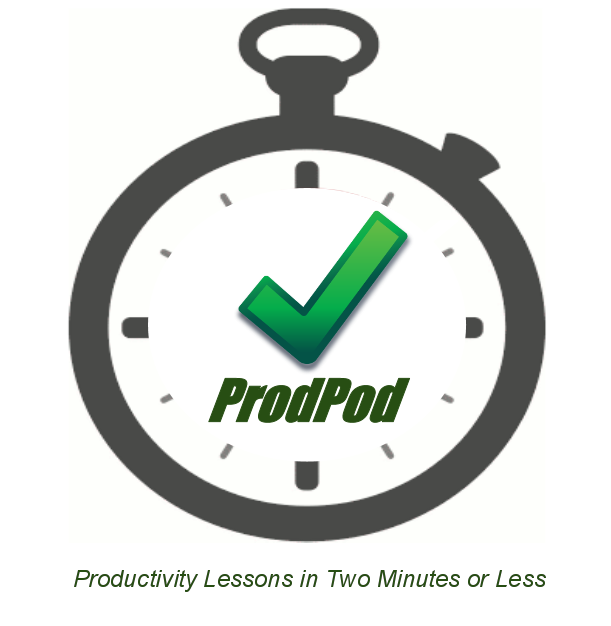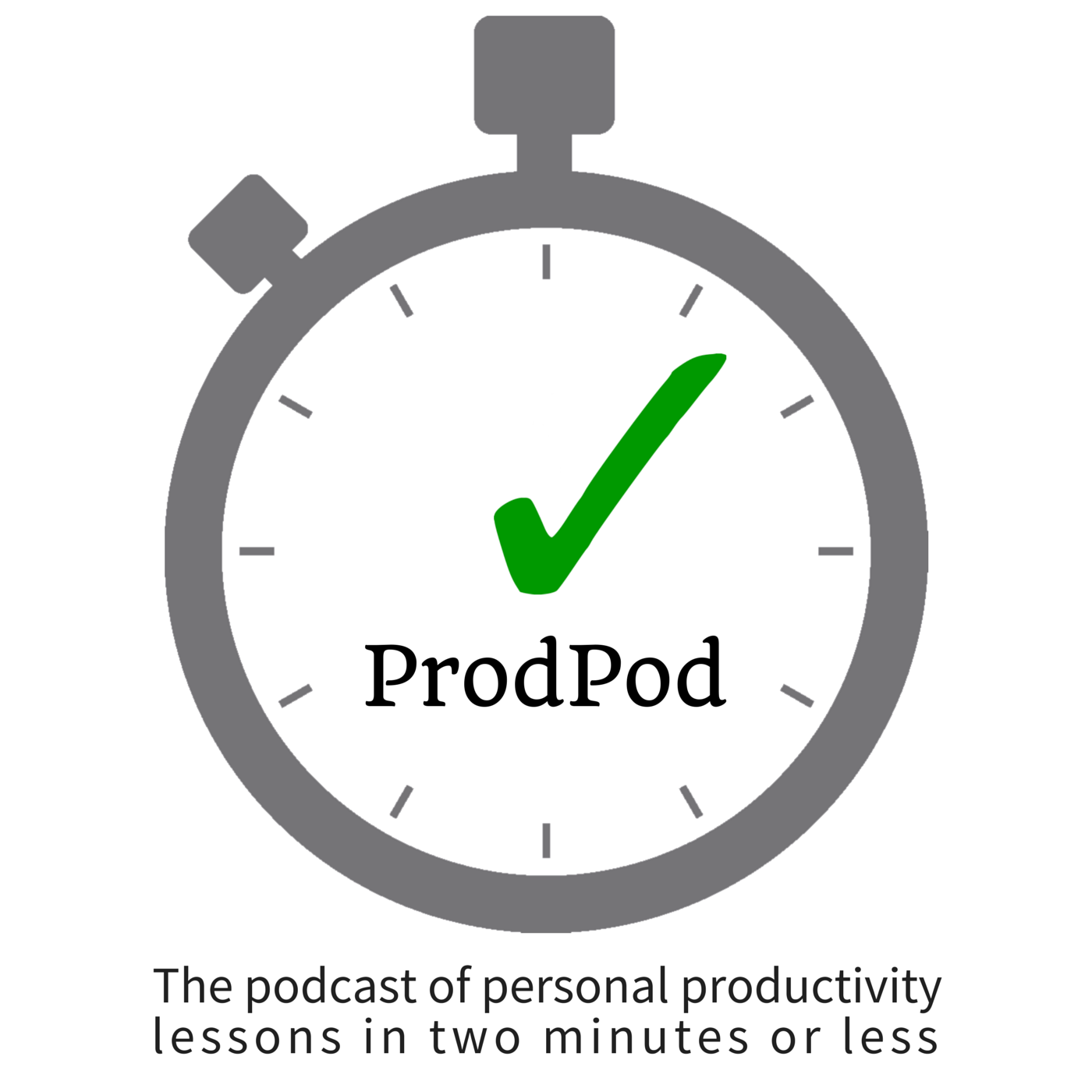Episodes

Tuesday Apr 10, 2012
Tuesday Apr 10, 2012
Welcome to Episode 33 of ProdPod, the podcast of productivity lessons in two minutes or less. I'm Ray Sidney-Smith, your productivity guide.
I'm rather comfortable with conflict resolution, but I see an abundance of poor conflict handling in the media today (especially coming from our politicians), I thought it might help to give an explanation of two foundational principles, Think Win-Win and Principled Negotiation, that have served me well in my business and personal life. If you've ever read Stephen Covey's The 7 Habits of Highly Effective People, you probably remember Habit #4, Think Win-Win. If you're not familiar, Dr. Covey basically espouses that you should strive for three win's in any long-term solution or agreement: mine, yours and ours. Therefore, if any of those three parties should lose, it's "no deal." The reasoning is that it's a loss for everyone in an interdependent group when one person loses. It was several years later while studying Conflict Resolution and Mediation that I learned about the book, Getting to Yes: Negotiating Agreement Without Giving In, [great summary here] by Fisher, Ury and Patton (a book that was born out of the Harvard Negotiation Project). This seminal work primarily focuses on teaching us Principled Negotiation, which is to:
- "separate people from the problems" (so that you can be compassionate with people, remove ego from the scenario as best as you can, and clearly see your other party's perspective);
- "focus on interests, not positions" (which brings the parties to discussing what they want and not their superficial stance when conflict arises);
- "mutual gains" (as the source of Covey's Habit #4 encouraging brainstorming and viewing the issues broadly); and
- "insist on using objective criteria" (by using fair standards decided upon upfront).

Wednesday Apr 04, 2012
ProdPod: Episode 32 -- Meditation's Power on Productivity
Wednesday Apr 04, 2012
Wednesday Apr 04, 2012
Welcome to Episode 32 of ProdPod, the podcast of productivity lessons in two minutes or less. I'm Ray Sidney-Smith, your productivity guide.
What do MRIs, Buddhist monks and meditation have to do with each other? It turns out, your productivity. There are many studies past and ongoing [here's a recent article of one such study] that reveal that meditation has innumerable benefits for helping the mind focus, which is one of the key ways in which we can take advantage of our productive hours of the day. However you express yourself secularly or spiritually, calling it meditation, prayer, quiet time, introspection or otherwise, as long as you focus your attention calmly and steadily, you can gain the mental benefits. By the act of teaching your brain to focus, the rest of the collateral benefits in your productive life follow naturally. I've meditated for many years and here's a quick exercise that I still practice to this day when I find it difficult to let go of my day ahead, or the day's events. With eyes closed, sit in a relaxed, quiet space. You may need ear plugs. And, you should turn your electronic devices off and put them somewhere outside of the room. Start at a small number, say, 20. Breathe deeply through your nose into your stomach (otherwise known as "diaphragmatic breathing" or "yogic breathing"), hold for a moment, and then slowly exhale to the count of three. As you do this, keep your hands rested supine on your legs to combat restlessness and raise your chest slightly as you inhale on occasion to fix your posture. Count silently, "Twenty." Take another deep breath into your diaphragm and repeat as you count down to one. Increase the number of your breaths as you find more time to meditate or reduce the number and tuck several sessions throughout the day. There are many meditative practices, so while this exercise may not fit you forever, use it while you find one that does. Your productivity will be glad you did.

Tuesday Mar 27, 2012
Tuesday Mar 27, 2012
Have you ever been at the bank and the power goes out? They can't do anything! It's quite frustrating and you basically need to step out of line and come back later. Period. Now, let's jump over to your personal productivity system. You've set up the perfect system using your desktop or Web-based tools. You're on top of the world. And, then, the power goes out, or you're on the road and your smartphone runs out of battery life. What now?
Of course, the power going out isn't the only frustration with digital productivity systems. If you have to work somewhere (like a satellite office location or a client's office) that lacks Internet access to outsiders, proper cellular signal or (as in the US Department of Defense) permission to bring in electronic devices, how will you manage? What happens when you fall off the wagon? Projects and tasks pile up or stagnate on your digital lists, right? Are you going to trust your inboxes and lists to manage yourself at that point? Probably not. These are just a few reasons I advocate that everyone who spends the effort developing a robust digital productivity system do themselves the favor of establishing a redundant framework in good old-fashioned paper. Some basic questions to ask yourself about a paper-based redundancy:
- Where will I put tasks and projects on paper should my computer or smartphone not be available?
- Can my digital system print to a paper list format? I happen to think this is a critical determinant for deciding to use any desktop or Web-based tool.
- How often will you test your paper system? Once a year, once a quarter or more often?
- I think that how often you test is a result of this next question: what aspects of my system do I need if my paper system needs to be around (a) just for today, (b) for the next week or next few weeks, or (c) for the near long-term?
- And, finally, how can I reduce transition cost (time, energy and other resources) between digital and paper?

Tuesday Jan 10, 2012
ProdPod: Episode 30 -- Two-Minute Book Summary: 18 Minutes by Peter Bregman
Tuesday Jan 10, 2012
Tuesday Jan 10, 2012
One of my favorite productivity reads of 2011 was 18 Minutes: Find Your Focus, Master Distraction, and Get the Right Things Done by Peter Bregman. Mr. Bregman assembled his book from his highly popular Harvard Business Review blog, and he endeavors to give insights and highly practical tips for just what the title states...and he delivers. In this episode, a summary of his concept of the 18-minute day, a powerful concept anyone can use for a more highly-productive and fulfilled life.
Five minutes at the beginning and ending of the day, plus one minute of every 8-hour workday equates to his 18 Minute Ritual.
1) At the beginning of the day, decide what you'll do today and calendar it.
2) Check in every hour with yourself. As Peter notes, "manage your day hour by hour. Don't let the hours manage you."
3) The end of day ritual.
1. How did the day go? What success did I experience? What challenges did I endure?
2. What did I learn today? About myself? About others? What do I plan to do differently or the same tomorrow?
3. Whom did I interact with? (Actions: And I need to update? Or thank? Or ask a question? Or share feedback?)
(Bregman gives this "end of day" ritual 5 minutes but it always takes me more time than that. Notwithstanding, there's his 18 minutes.)
Paraphrasing the author about this "end of day" ritual, "These minutes" of reflection and quick actions "are the way to making tomorrow even better than today."
I'll leave you with my favorite quotation in the book from Peter Bregman.
"The world doesn't reward perfection/ It rewards productivity."

Tuesday Dec 27, 2011
ProdPod: Episode 29 -- Personal Stress Audit
Tuesday Dec 27, 2011
Tuesday Dec 27, 2011
I recently re-read a book I picked up a few years ago by Clare Harris called Conquer Stress, Achieve Success, and it describes something I advocate highly: doing a personal stress audit.
Here's Clare's process:
First: Find a quiet space where you're comfortable and won't be disturbed. You may even want to do a relaxation technique or meditate for a few minutes to release any tensions from the outside world at that moment. Then, with pen and a notepad, make a list of all the most important events that occurred in the last two years.
Next: Create a list or pie chart of the different areas of your life. In GTD, we call these Areas of Focus and Areas of Responsibility combined.
Now, you can go category by category and write down anything that makes you feel stressed, tense or anxious, sad, angry, limited or judged. The author notes you should make sure not to self-judge or self-censor while doing this part of the exercise. Continue writing down items with their categories until you've exhausted ideas.
Then, lay out the categorized lists, mindmaps or however you created them, and look for commonalities, patterns and relationships among the categories' items. From here you should be able to do two things: 1) note which items need change, and 2) asterisk which items need change as soon as possible!
Finally, the part most people leave out when doing any kind of assessment: create a strategy for change! Using SMART goals (see episode 19), create steps for achieving a lower-stress lifestyle. Make sure to include key players in your life: your boss, your spouse, family, friends, coworkers and children.
You know you've reached a point of success when you can start checking off items from your SMART goals list for reducing stress.

